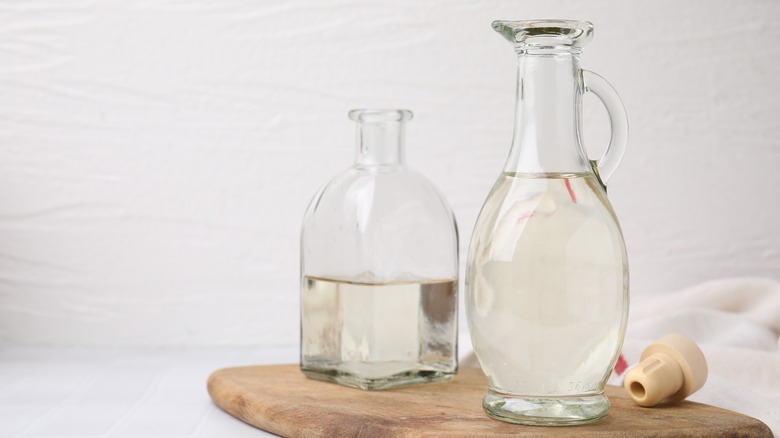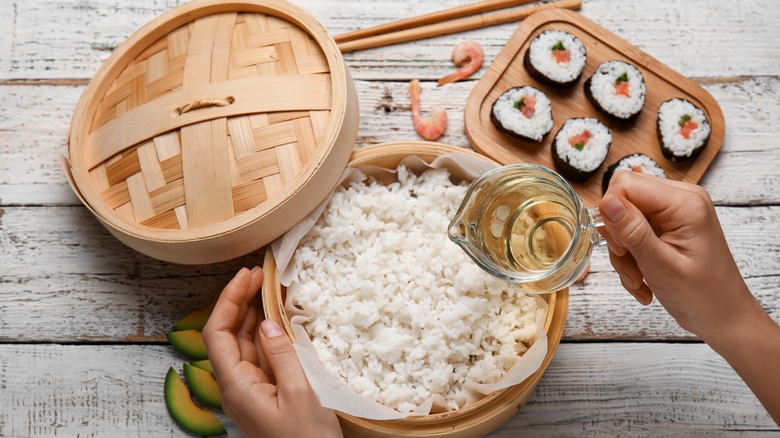Champagne Vinegar Vs Rice: What's The Difference?
There are many kinds of vinegar available and, despite sharing a few basic similarities such as the fermentation process of making it, all of them have different tastes and uses. Distilled vinegar is great for pickling, for example, while cider-based vinegars go great on salads.
Two of the more interesting vinegars are champagne and rice (also called rice wine) vinegar. Both have mild, slightly sweet flavors with slightly less acidity than other vinegars. They're perfect for adding just a dash of sour vinegar twang to dishes without altering the primary flavors. This also makes them excellent substitutions for each other.
While most champagne vinegar isn't much different from any other, rice vinegar comes in several varieties with different flavor profiles and uses. The closest to champagne are regular (also called white or unseasoned) and seasoned rice vinegars. The former is the most direct 1-to-1, though white rice vinegar has a little extra sweetness compared to champagne (champagne vinegar is slightly fruitier in turn). Seasoned rice vinegar cranks the sweetness up with added sugars, plus flavor boosters such as salt or MSG.
How to use champagne vinegar
Champagne vinegar, which you can make at home using leftover champagne or sparkling wine, should be used in lighter dishes to match its light flavor. Otherwise, it may be lost among other, stronger ingredients. It's perfect for a light salad dressing, for example — especially one with fruity elements, such as apples or cranberries. Seasoned rice vinegar would be the best substitute in this case, though you do need to be cognizant of the extra sugar to avoid unbalancing your dressing.
Champagne vinegar's lightness and crispness is also a great fit for summer staples, such as potato salad and coleslaw. Both these dishes can be made mainly with mayo, but going the vinegar-focused route makes them lighter, crisper and, by using champagne vinegar, slightly sweet and fruity. It makes these sides a better match to heavy mains, such as brisket or fried chicken. White rice vinegar would be the better substitute here, letting you take your recipe in more focused directions than seasoned rice vinegar's extra sweetness would allow.
How to use rice vinegar
Between white and seasoned rice vinegar, white is the more adaptable since it's the lightest on flavors. It's best used in recipes where you want the vinegar kick, but want it to be subtler and tastier than using regular white or distilled vinegars. Champagne vinegar could be used in a pinch here, but has enough detectable flavor that you need to account for it when subbing it in.
If, however, you want more flavor, then seasoned rice vinegar is what to reach for. It's an excellent (and common) addition to sushi rice, for example, and it can add wonderful flavor to soups such as Vietnamese bùn or gazpacho. Champagne vinegar is an easier swap here, but it has a slightly fruitier and less sweet effect to watch out for.
Before we go, a quick note on other rice vinegars. Brown rice vinegar, made from, yep, brown rice, has an earthy flavor and darker color. If the color goes dark enough, it can be called black rice vinegar. There's also a black rice vinegar out of Taiwan — made by steeping ingredients such as vegetables and fruits in white vinegar — and a black rice vinegar made from black rice. Finally, a sweet-and-sour red rice vinegar comes from red yeast rice.


